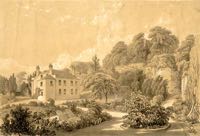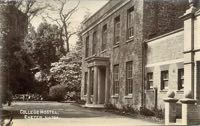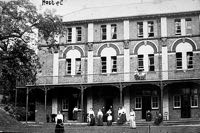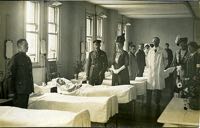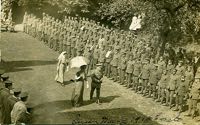
Bradninch Hall
aka The Vineyard
Page added 21st December 2018
Rougemont Castle and the small district adjoining, were part of the Duchy of Cornwall when Edward III created his eldest son, Edward, Duke of Cornwall. With the demise of the castle as a fortified structure, the moat surrounding it on the southern and western sides became available for other uses. Rougemont House was built by John Patch in 1769, and the western moat turned into a garden while the land to the east of the castle entrance lay undeveloped.
Brice, in 1802, mentions that Mr Frankpit had a quarry in his garden, under the castle wall. Oliver’s History of Exeter also mentions that the land was planted as a vineyard by Mr Frankpit. By 1832, the Dawson map shows an empty plot of land. The Brown map of 1835 shows the existence of the house, so it would appear to have been constructed in the first part of the 1830s. The house was a family home from when it was built, known as The Vineyard after the original use of the land. There is no reference in the local newspapers to the house on the site before the 1850s.
The building is of the local Heavitree stone. It is a friable breccia, which in this case is uncut, giving a crazy paving type finish, with red brick quoins on the corners and around the sash windows. The front entrance is of a simple and elegant Tuscan design, with a honeysuckle fanlight. There is a moulded cornice topped with a brick parapet and three dormers added later on each side of the double gabled roof.
In 1902, it was purchased by the University College of Exeter for use as a student hostel. In 1905 plans were made to add a new building named Bradninch Place, at right angles to the house.
War Hospital
In 1914, when war broke out, the British Expeditionary Force were shipped to France. Soon, casualties were being shipped back to the UK, and Exeter became one of the destinations for the wounded, as existing hospital facilities and other institutions were converted for war use. New facilities were opened as the casualties mounted, and in May 1915 the female students were moved to Hartwell House, and the College Hostel and the adjacent Congregational Church School (now the Timepiece nightclub) became No V Hospital. The buildings needed some modifications to make them suitable for their task. J W Jerman was the architect under the supervision of medical officer Mr Brennan Dyball, who had joined the Royal Devon and Exeter Hospital in 1912 as a surgeon.
No V Hospital had 200 beds, 177 were in seven wards, the largest of which had 40 beds. By May 14th 100 beds were occupied by casualties, with the remaining being available from June 1st. By July 31st 342 patients had been admitted. In April 1916 Pte. William Young, of the 8th East Lancashire Regiment, a patient at the hospital was awarded the Victoria Cross.
In June 1919 the hospital was handed back to the University College and the first students moved into the hostel in the Autumn of 1919.
Back to a college
In 1922 University College became the University College of the South West of England, a name it would retain until 1955 when Queen Elizabeth granted the institution its charter to become the University of Exeter.
The female students at Bradninch Hall, as it was referred to was, were moved to Lopes Hall in 1933 and the building was taken over by Devon County Council for the offices of the Education Committee. During the Second War, Bradninch Hall was home to a variety of uses administered by the City council, especially related to children and employment. After the war the Hall remained as part of the University until 1988. Now it is occupied by commercial companies and the WEA, among other uses.
As a private residence
Nothing is known of the occupiers of The Vineyard until 1855, when the wife of William Lambert gave birth to a son at the house. This was followed by a daughter in 1857. Lambert was a solicitor at 9 Queen Street.
Dr Richard Pennel was recorder as the resident at the house in 1861. He was appointed as a physician to the Devon and Exeter Hospital in November 1830. He later became a magistrate before resigning from the hospital and leaving Exeter in September 1850. He must have returned to the city to be living at The Vineyard in 1861.
Charles Wescomb moved into The Vineyard in 1863. The son of a bricklayer, he was born in Paris Street in 1828, and was brought up by his widowed mother. He became a schoolmaster in Budleigh Salterton, and helped a toll keeper to keep his accounts. He moved back to Exeter and became a share broker, advising clients on their investments. He was fond of entertaining, and became a popular figure in the city. In 1857, when Edward Woolmer, owner of the Gazette died, Wescomb purchased the paper. He expanded his financial empire by investing in west country mines, property, and was thought to have been instrumental in developing Budleigh Salterton.
A Conservative, Wescomb became well acquainted with Sir Stafford Northcote and Adullamite Robert Lowe. By 1866, he purchased newspapers in Edinburgh, Deal and Maidstone, as well as a share of the, Conservative, London Globe. He was Sheriff of the city in 1868, and was influential in establishing the Albert Memorial Museum. As far as Exeter was concerned, he was a self made man, and a son of the city to be proud of.
However, Charles Wescomb had a secret. In May 1869, he had a shareholders meeting, in London, for the Frank Mills Mine, near Christow. Soon after, he died of a stroke. When the news reached Exeter, the city went into mourning. Many shops closed in respect, while the Cathedral organ played the Dead March from Saul. When his affairs were investigated, it was found that his fortune was based on debt. He had borrowed recklessly, as his business interests and investments declined. Many, who had invested in shares that he had brokered, lost money–not all were wealthy, including a widow who lived in Gatty’s Court, Sidwell Street, who lost her savings. She lived on 3s a week, of which half was rent.
Wescomb left The Vineyard in 1868, a year before his death, possibly because it became too expensive for him to run.
The next occupier of the house was Edward Knapman, who ran on the Conservative Working Mens’ Union ticket for St Davids Ward in late 1869. In later years, the house was occupied by a variety of tenants, including another solicitor, T J Bremridge. He hosted the British Association in their inspection of the historic castle wall, situated in his garden. His widow stayed in residence until her death in 1901. On 1 January 1902, the house was purchased to be used as a women’s hostel.
Sources: Exeter Flying Post, Exeter and Plymouth Gazette, Western Times, The History of the City of Exeter, by the Rev., George Oliver. Entry in the British Listed Buildings website. University Exeter Halls of Residence Wikipedia entry. The History and Description, Ancient and Modern, of the City of Exeter by Thomas Brice
│ Top of Page │
